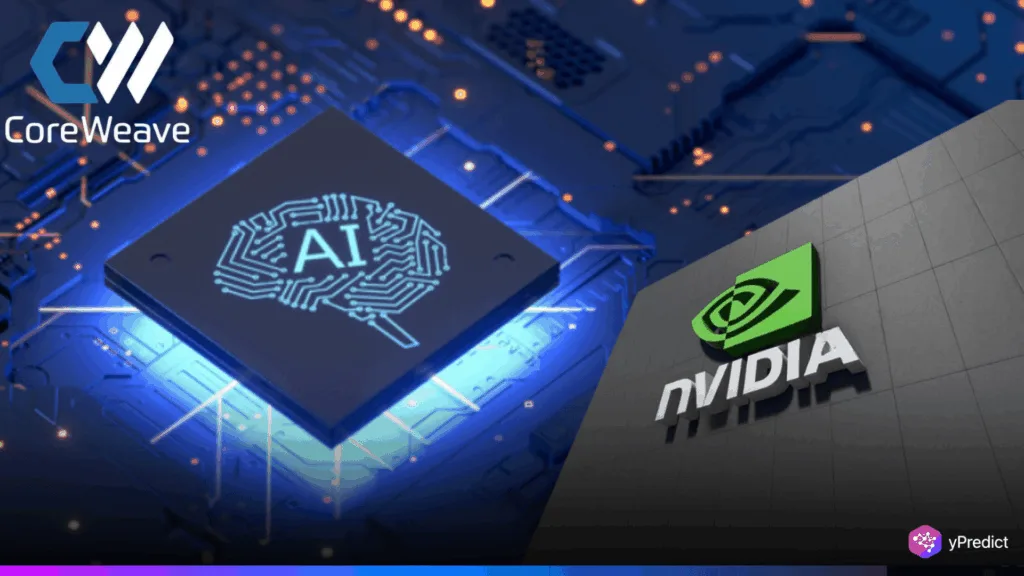
Nvidia-backed CoreWeave delivered impressive first-quarter results in its debut as a public company. It exceeded Wall Street’s projections, indicating significant momentum in the field of AI cloud computing. The New Jersey-based company, which was founded by Mike Intrator, exceeded analyst forecasts with $981.6 million in revenue.
With a huge five-year contract from OpenAI and high demand from Microsoft, CoreWeave is quickly establishing itself as a key participant in the ecosystem of AI infrastructure. With a revenue backlog approaching $26 billion, the company anticipates strong growth despite significant capital expenditures.
CoreWeave’s Growth Fueled by AI Cloud Computing
The rising demand for AI cloud computing has been the driving force behind CoreWeave’s entry into markets. For the development of generative AI, the company’s services give users access to scalable data centers and Nvidia chips. Its recent collaboration with OpenAI alone increased its revenue backlog by $11.2 billion, demonstrating the industry’s faith in CoreWeave’s infrastructure prowess.
Following the release of the results, the company’s stock rose 11% in extended trading. Despite having a low-key March debut, the shares have already risen by 68%. Due to its positioning as a high-performance computing backbone provider, CoreWeave holds a distinct advantage in the emerging AI economy. This edge becomes more crucial as competition in generative AI intensifies.
Can CoreWeave Maintain Momentum With High Spending?
CoreWeave’s Q1 revenue of $981.6 million beat the analyst consensus of $852.9 million. It anticipates revenue for the full year to be between $4.9 billion and $5.1 billion, which is significantly more than analysts had predicted. The $25.9 billion backlog includes contributions from Microsoft and OpenAI, among other major clients.
However, the high projected capital expenditures of $20 to $23 billion for 2025 caused investors to express caution. Compared to its estimated revenue of $1.06 to $1.1 billion, CoreWeave expects to spend between $3 billion and $3.5 billion for Q2 alone. Despite immediate worries, CEO Mike Intrator underlined that these expenditures are required to sustain long-term profit and maintain market leadership.
Additionally, Intrator asserts that it allows CoreWeave to fully recover infrastructure costs while maintaining margins. Due to trade tensions between the United States and China, the company is also attempting to diversify its supply chains. Its commitment to stability and growth in the data center sector is being demonstrated by this.
What’s Next for CoreWeave in AI Expansion?
CoreWeave’s heavy investment signals a long-term vision centered around AI cloud computing. Its emphasis on infrastructure scalability is intended to satisfy growing demands from customers such as Microsoft, which presently uses CoreWeave for excess processing power. However, experts warn that Microsoft’s requirements could evolve in the future.
Despite this, the business is optimistic. As the AI race heats up, companies require dependable infrastructure. CoreWeave has a strong advantage because it can provide high-speed processing with Nvidia chips. Another example of creative business structuring is the partnership model with OpenAI, in which it contributes infrastructure and OpenAI receives equity.
The company’s growth strategy for the future includes not only building more data centers but also making sure they are profitable and sustainable. According to Intrator, CoreWeave seeks to strike a balance between long-term profits and investment. By coordinating its growth with market developments, it hopes to play a key role in the upcoming AI revolution.
CoreWeave Eyes Long-Term AI Cloud Computing Edge
CoreWeave has demonstrated in its first quarter that it can grow in a competitive market. The company is establishing a long-lasting business around AI cloud computing through strong alliances and the strategic use of Nvidia chips. Due to its status as a significant infrastructure provider, the company is quickly adapting to the AI sector.





